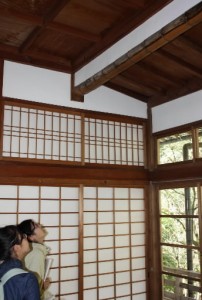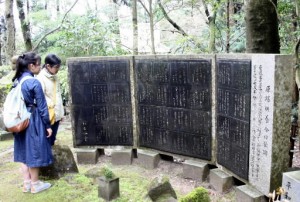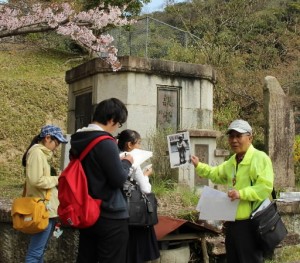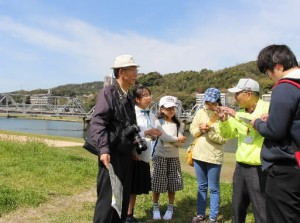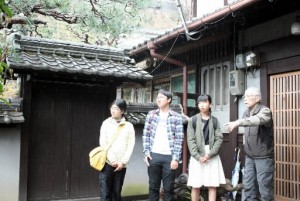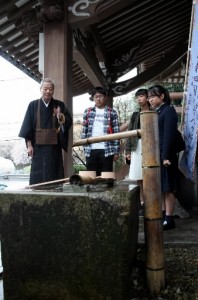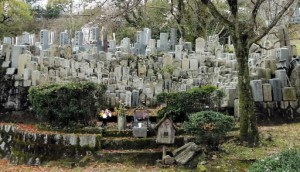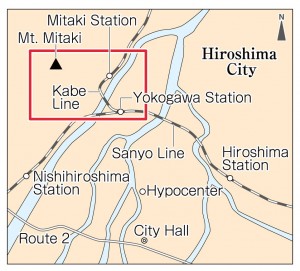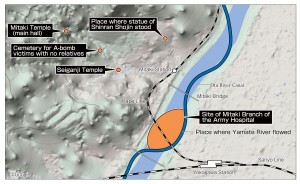Peace Seeds: Teens in Hiroshima Sow Seeds of Peace (Part 31)
Apr. 21, 2016
Part 31: Scars from the atomic bombing still seen on Mt. Mitaki
When the atomic bomb was dropped on Hiroshima, many people fled to the mountains which ring the city center. One such destination was Mt. Mitaki, located about 2.5 to 3.5 kilometers northwest of the bomb’s hypocenter. But some people collapsed along the way, their bodies finally floating in the Yamate River (now the Ota River Canal) at the foot of the mountain. The massive blast blew off roofs of Mt. Mitaki buildings and the tremendous heat ignited fires in the area.
A number of A-bomb-related sites are found on Mt. Mitaki: the grounds of Mitaki Temple have many A-bombed structures and monuments; Seiganji Temple was moved from the Nakajima district, where the Hiroshima Peace Memorial Park was created after World War II; a cemetery sits with the graves of those who left behind no relatives because all other family members were killed in the atomic bombing; and the pedestal of a statue of Shinran Shonin, the founder of a Buddhist sect, which was taken to New York with the hope of advancing the abolition of nuclear weapons. Mt. Mitaki is also known as a place to pray for peace. The top of the mountain offers a full view of the city center. Why not climb the mountain and contemplate creating a peaceful world?
Mitaki Temple: A-bomb tragedy is inscribed on buildings and monuments
On the grounds of Mitaki Temple are five structures registered with the City of Hiroshima as A-bombed buildings as well as many memorial monuments. The roof of the main temple hall was blown off by the blast then reconstructed, but the Chinju-do Hall (a guardian god hall) and Soshin Kannon-do (a temple dedicated to the Buddhist deity connected to parents) were left intact. Sanki Gongen-do Hall (a three-demon-god hall) was warped by the bombing, and this can be recognized when sitting inside the building.
The main temple was built shortly after the war, and bamboo which had been partly charred by the A-bomb blast was used. The head priest at that time chose to use this bamboo because he wished to convey the damage that Mt. Mitaki suffered.
On August 6, 1945, the atomic bombing spontaneously set Mt. Mitaki trees on fire. The waterfalls there, a symbol of the mountain, turned black from smoke and soot. About two days later, people seeking refuge began gathering at Mt. Mitaki and some remained there until 15 years after the bombing.
The number of A-bomb monuments on the temple grounds is not readily apparent. Gensen Sato, 59, the head priest, said, “It is cool here and water is abundant. This is an appropriate place, I think, to pray for those who died as they pleaded for water in the heat of summer.” The water from the cascading waterfall is offered to the Cenotaph for the A-bomb Victims in the Peace Memorial Park for the annual Peace Memorial Ceremony on August 6.
In 1951, the two-storied pagoda near the entrance (designated an important cultural asset by Hiroshima prefecture) was moved from a shrine in Wakayama Prefecture to offer prayers for the repose of the A-bomb victims by people who were from Hiroshima and lived in the Kansai region. After the 33rd anniversary of the atomic bombing, various monuments were erected: stone monuments inscribed with haiku(a Japanese poem of 17 syllables) and tanka (a Japanese poem of 31 syllables) respectively, a monument engraved with waka (a traditional Japanese poem of 31 syllables), and a monument for the Holocaust victims (the genocide of the Jewish people) at Auschwitz. (Harumi Okada, 17, and Kotoori Kawagishi, 13)
Site of burned statue, now in New York
A little ways up Mt. Mitaki is the spot where the statue of Shinran Shonin once stood. Seiichi Hirose, who ran an ironworks in the Kansai region, placed the statue here in 1937 after his small daughter died. He decided to erect the statue in Hiroshima because of the many Jodo Shinshu believers in the city. The large statue was four meters tall.
On August 6, 1945, the statue, which stood facing the city center, was exposed to the heat rays of the atomic bomb and the front was badly scorched.
Then, in 1955, the statue was moved to the New York Buddhist Church to spread the message of “No more Hiroshimas” to the world. To the people there, it still conveys the importance of peace. (Yui Morimoto, 12)
Mitaki Branch of the Army Hospital became a first-aid station
The Mitaki Branch of the Army Hospital was built on the side of the Yamate River in 1937, when the Sino-Japanese War broke out. At the time of the atomic bombing, the first-aid station was set up there, then was dismantled in 1947.
The place where the Mitaki Branch stood was turned into the Ota River Canal. In 1932, the Japanese Diet decided to merge the Yamate River, which frequently overflowed its banks, and the Fukushima River into one wide river. Two years later, the construction work began, but then was suspended because of World War II. It was completed in 1967, a project that spanned 35 years. (Ishin Nakahara, 17)
Memories of the A-bombing from the foot of Mt. Mitaki
Shiro Doi, 80, a local resident at the foot of Mt. Mitaki, was born and raised in a house built more than 150 years ago in the Edo Period, and still lives there today. When the atomic bomb exploded, the roof tiles and sliding doors were blown off, the ceiling collapsed, and the whole house tilted to one side. The blast also hit the storehouse through the open door and its walls bulged outward.
Mr. Doi was in fourth grade at Oshiba National School back then. He attended classes at the youth center located in Mitaki-cho on the east side of the Yamate River. On the morning of August 6, he was “it” and counting to 100 in a game of hide-and-seek with friends, when he noticed a B-29 bomber in the sky. Suddenly, there was a flash of blinding light and, before he knew it, he was blown about ten meters through the air and fragments of glass had pierced his head.
Though he managed to return home, he was unable to enter because of the wreckage. There were less than 30 homes in his district, and he saw at least seven of them on fire, their thatched roofs burning.
Many people fled from the city center to Mitaki, seeking water. Only a little water was flowing in the Yamate River in front of Mr. Doi’s house, but there were many bodies in the river. Soldiers, using poles, retrieved the bodies from the water and poured oil over them to cremate them by the side of the river. (Hisashi Iwata, 16)
Seigainji Temple holds cemetery for those with no relatives
Seiganji Temple was formerly located in the Zaimoku-cho district, an area that was transformed into the Hiroshima Peace Memorial Park, and the temple was relocated to Mitaki after the atomic bombing. A cemetery at the temple provides a resting place for the dead who had no relatives left because entire families perished in the bombing. An A-bombed stone basin is still being used there.
Seiganji Temple was located about 400 meters from the hypocenter and was annihilated by the atomic bomb, which left no trace of the temple behind. After the war, it was decided that the Peace Memorial Park would be created on land that had been occupied by Seiganji Temple. In response to a proposal by the municipal government, roughly 200 to 300 graves among the 2500 graves once found at the temple cemetery were moved to Mitaki. With donations from followers of the temple, the temporary main temple hall was built just south of the site where the temple had formerly stood, but in 1963 it was rebuilt in its current location because it was better for the temple to be near the cemetery.
There is also a memorial tower for the A-bomb victims in the village of Kawauchi (now part of Asaminami Ward). On the morning of the atomic bombing, residents of Kawauchi who had come to Hiroshima to help tear down homes to create a fire lane lost their lives while resting at Seiganji Temple. The memorial tower was erected in 1951, and when the temple was relocated, the tower was brought to Mitaki, too. (Nanaho Yamamoto, 17)
Junior writers’ impressions
The thing that struck me most about my interview is the bamboo from the atomic bombing that has remained as part of the building. When I first heard about this, I couldn’t imagine the damage done to the bamboo and how it was used. When I saw it with my own eyes, the damaging effects of the bombing were clear. I want to write more articles that are easy to understand, like this article about the A-bombed bamboo. (Kotoori Kawagishi)
As I gathered information about Seiganji Temple, the most striking thing to me was the stone basin. I could sense how powerful the blast was in breaking solid rock and how horrific the bomb was as it scorched the stone. (Nanaho Yamamoto)
To work on this article, I walked a lot around the Mitaki district. On foot, I could imagine how the people who experienced the atomic bombing felt. I was able to view the city center from Mitaki Temple, halfway up the mountain, and it was unbelievable to me that such a wide area was turned into burnt rubble 70 years ago. (Ishin Nakahara)
I thought Mt. Mitaki was far from the hypocenter because I had never been there. So when I heard about the burnt bamboo, it seemed strange. But when I actually climbed Mt. Mitaki and looked out over the city, I realized that the hypocenter was closer than I thought. I usually learn about the damage and danger of the atomic bombing by listening to accounts and reading books, but I found that I could think more profoundly about what happened by actually visiting an A-bombed site first-hand. (Harumi Okada)
I was very surprised to learn that the A-bombed statue of Shinran Shonin was moved to the United States, the country which dropped the atomic bomb, only ten years after the war. I sympathize with the reason, in that it was brought there to spread the message of “No more Hiroshimas” to the world. People out in the world can understand the horror of the atomic bombing better, even just a little, when A-bombed artifacts can be viewed in other countries, too. I hope that the statue of Shinran Shonin can continue to convey the horror of the atomic bombing to many people. (Ai Mizoue)
I took part in the interviews about Seiganji Temple and Mr. Doi. I asked Mr. Doi, “Are you happy living in Mitaki?” He said, “It’s not that I’m happy to live in Mitaki simply because I was born and raised here.” I was impressed with his words, which I took to mean he considers Mitaki his home regardless of the fact that he was born and raised there. This is a very romantic view of our home, I think. (Hisashi Iwata)
I was surprised to learn that the statue of Shinran Shonin in New York suffered damage in both the atomic bombing of Hiroshima and the terrorist attacks that took place in New York on September 11, 2001. I hope the people of New York will continue doing their best to think about peace, even a little. (Yui Morimoto)
What is Peace Seeds?
Peace Seeds are the seeds of smiles which can be spread around the world by thinking about peace and the preciousness of life from various viewpoints. To fill this world with flowering smiles, 39 junior writers, from the first year junior high school to the sixth year of high school, choose themes, gather information, and write articles.
(Originally published on April 21, 2016)
When the atomic bomb was dropped on Hiroshima, many people fled to the mountains which ring the city center. One such destination was Mt. Mitaki, located about 2.5 to 3.5 kilometers northwest of the bomb’s hypocenter. But some people collapsed along the way, their bodies finally floating in the Yamate River (now the Ota River Canal) at the foot of the mountain. The massive blast blew off roofs of Mt. Mitaki buildings and the tremendous heat ignited fires in the area.
A number of A-bomb-related sites are found on Mt. Mitaki: the grounds of Mitaki Temple have many A-bombed structures and monuments; Seiganji Temple was moved from the Nakajima district, where the Hiroshima Peace Memorial Park was created after World War II; a cemetery sits with the graves of those who left behind no relatives because all other family members were killed in the atomic bombing; and the pedestal of a statue of Shinran Shonin, the founder of a Buddhist sect, which was taken to New York with the hope of advancing the abolition of nuclear weapons. Mt. Mitaki is also known as a place to pray for peace. The top of the mountain offers a full view of the city center. Why not climb the mountain and contemplate creating a peaceful world?
Mitaki Temple: A-bomb tragedy is inscribed on buildings and monuments
On the grounds of Mitaki Temple are five structures registered with the City of Hiroshima as A-bombed buildings as well as many memorial monuments. The roof of the main temple hall was blown off by the blast then reconstructed, but the Chinju-do Hall (a guardian god hall) and Soshin Kannon-do (a temple dedicated to the Buddhist deity connected to parents) were left intact. Sanki Gongen-do Hall (a three-demon-god hall) was warped by the bombing, and this can be recognized when sitting inside the building.
The main temple was built shortly after the war, and bamboo which had been partly charred by the A-bomb blast was used. The head priest at that time chose to use this bamboo because he wished to convey the damage that Mt. Mitaki suffered.
On August 6, 1945, the atomic bombing spontaneously set Mt. Mitaki trees on fire. The waterfalls there, a symbol of the mountain, turned black from smoke and soot. About two days later, people seeking refuge began gathering at Mt. Mitaki and some remained there until 15 years after the bombing.
The number of A-bomb monuments on the temple grounds is not readily apparent. Gensen Sato, 59, the head priest, said, “It is cool here and water is abundant. This is an appropriate place, I think, to pray for those who died as they pleaded for water in the heat of summer.” The water from the cascading waterfall is offered to the Cenotaph for the A-bomb Victims in the Peace Memorial Park for the annual Peace Memorial Ceremony on August 6.
In 1951, the two-storied pagoda near the entrance (designated an important cultural asset by Hiroshima prefecture) was moved from a shrine in Wakayama Prefecture to offer prayers for the repose of the A-bomb victims by people who were from Hiroshima and lived in the Kansai region. After the 33rd anniversary of the atomic bombing, various monuments were erected: stone monuments inscribed with haiku(a Japanese poem of 17 syllables) and tanka (a Japanese poem of 31 syllables) respectively, a monument engraved with waka (a traditional Japanese poem of 31 syllables), and a monument for the Holocaust victims (the genocide of the Jewish people) at Auschwitz. (Harumi Okada, 17, and Kotoori Kawagishi, 13)
Site of burned statue, now in New York
A little ways up Mt. Mitaki is the spot where the statue of Shinran Shonin once stood. Seiichi Hirose, who ran an ironworks in the Kansai region, placed the statue here in 1937 after his small daughter died. He decided to erect the statue in Hiroshima because of the many Jodo Shinshu believers in the city. The large statue was four meters tall.
On August 6, 1945, the statue, which stood facing the city center, was exposed to the heat rays of the atomic bomb and the front was badly scorched.
Then, in 1955, the statue was moved to the New York Buddhist Church to spread the message of “No more Hiroshimas” to the world. To the people there, it still conveys the importance of peace. (Yui Morimoto, 12)
Mitaki Branch of the Army Hospital became a first-aid station
The Mitaki Branch of the Army Hospital was built on the side of the Yamate River in 1937, when the Sino-Japanese War broke out. At the time of the atomic bombing, the first-aid station was set up there, then was dismantled in 1947.
The place where the Mitaki Branch stood was turned into the Ota River Canal. In 1932, the Japanese Diet decided to merge the Yamate River, which frequently overflowed its banks, and the Fukushima River into one wide river. Two years later, the construction work began, but then was suspended because of World War II. It was completed in 1967, a project that spanned 35 years. (Ishin Nakahara, 17)
Memories of the A-bombing from the foot of Mt. Mitaki
Shiro Doi, 80, a local resident at the foot of Mt. Mitaki, was born and raised in a house built more than 150 years ago in the Edo Period, and still lives there today. When the atomic bomb exploded, the roof tiles and sliding doors were blown off, the ceiling collapsed, and the whole house tilted to one side. The blast also hit the storehouse through the open door and its walls bulged outward.
Mr. Doi was in fourth grade at Oshiba National School back then. He attended classes at the youth center located in Mitaki-cho on the east side of the Yamate River. On the morning of August 6, he was “it” and counting to 100 in a game of hide-and-seek with friends, when he noticed a B-29 bomber in the sky. Suddenly, there was a flash of blinding light and, before he knew it, he was blown about ten meters through the air and fragments of glass had pierced his head.
Though he managed to return home, he was unable to enter because of the wreckage. There were less than 30 homes in his district, and he saw at least seven of them on fire, their thatched roofs burning.
Many people fled from the city center to Mitaki, seeking water. Only a little water was flowing in the Yamate River in front of Mr. Doi’s house, but there were many bodies in the river. Soldiers, using poles, retrieved the bodies from the water and poured oil over them to cremate them by the side of the river. (Hisashi Iwata, 16)
Seigainji Temple holds cemetery for those with no relatives
Seiganji Temple was formerly located in the Zaimoku-cho district, an area that was transformed into the Hiroshima Peace Memorial Park, and the temple was relocated to Mitaki after the atomic bombing. A cemetery at the temple provides a resting place for the dead who had no relatives left because entire families perished in the bombing. An A-bombed stone basin is still being used there.
Seiganji Temple was located about 400 meters from the hypocenter and was annihilated by the atomic bomb, which left no trace of the temple behind. After the war, it was decided that the Peace Memorial Park would be created on land that had been occupied by Seiganji Temple. In response to a proposal by the municipal government, roughly 200 to 300 graves among the 2500 graves once found at the temple cemetery were moved to Mitaki. With donations from followers of the temple, the temporary main temple hall was built just south of the site where the temple had formerly stood, but in 1963 it was rebuilt in its current location because it was better for the temple to be near the cemetery.
There is also a memorial tower for the A-bomb victims in the village of Kawauchi (now part of Asaminami Ward). On the morning of the atomic bombing, residents of Kawauchi who had come to Hiroshima to help tear down homes to create a fire lane lost their lives while resting at Seiganji Temple. The memorial tower was erected in 1951, and when the temple was relocated, the tower was brought to Mitaki, too. (Nanaho Yamamoto, 17)
Junior writers’ impressions
The thing that struck me most about my interview is the bamboo from the atomic bombing that has remained as part of the building. When I first heard about this, I couldn’t imagine the damage done to the bamboo and how it was used. When I saw it with my own eyes, the damaging effects of the bombing were clear. I want to write more articles that are easy to understand, like this article about the A-bombed bamboo. (Kotoori Kawagishi)
As I gathered information about Seiganji Temple, the most striking thing to me was the stone basin. I could sense how powerful the blast was in breaking solid rock and how horrific the bomb was as it scorched the stone. (Nanaho Yamamoto)
To work on this article, I walked a lot around the Mitaki district. On foot, I could imagine how the people who experienced the atomic bombing felt. I was able to view the city center from Mitaki Temple, halfway up the mountain, and it was unbelievable to me that such a wide area was turned into burnt rubble 70 years ago. (Ishin Nakahara)
I thought Mt. Mitaki was far from the hypocenter because I had never been there. So when I heard about the burnt bamboo, it seemed strange. But when I actually climbed Mt. Mitaki and looked out over the city, I realized that the hypocenter was closer than I thought. I usually learn about the damage and danger of the atomic bombing by listening to accounts and reading books, but I found that I could think more profoundly about what happened by actually visiting an A-bombed site first-hand. (Harumi Okada)
I was very surprised to learn that the A-bombed statue of Shinran Shonin was moved to the United States, the country which dropped the atomic bomb, only ten years after the war. I sympathize with the reason, in that it was brought there to spread the message of “No more Hiroshimas” to the world. People out in the world can understand the horror of the atomic bombing better, even just a little, when A-bombed artifacts can be viewed in other countries, too. I hope that the statue of Shinran Shonin can continue to convey the horror of the atomic bombing to many people. (Ai Mizoue)
I took part in the interviews about Seiganji Temple and Mr. Doi. I asked Mr. Doi, “Are you happy living in Mitaki?” He said, “It’s not that I’m happy to live in Mitaki simply because I was born and raised here.” I was impressed with his words, which I took to mean he considers Mitaki his home regardless of the fact that he was born and raised there. This is a very romantic view of our home, I think. (Hisashi Iwata)
I was surprised to learn that the statue of Shinran Shonin in New York suffered damage in both the atomic bombing of Hiroshima and the terrorist attacks that took place in New York on September 11, 2001. I hope the people of New York will continue doing their best to think about peace, even a little. (Yui Morimoto)
What is Peace Seeds?
Peace Seeds are the seeds of smiles which can be spread around the world by thinking about peace and the preciousness of life from various viewpoints. To fill this world with flowering smiles, 39 junior writers, from the first year junior high school to the sixth year of high school, choose themes, gather information, and write articles.
(Originally published on April 21, 2016)

